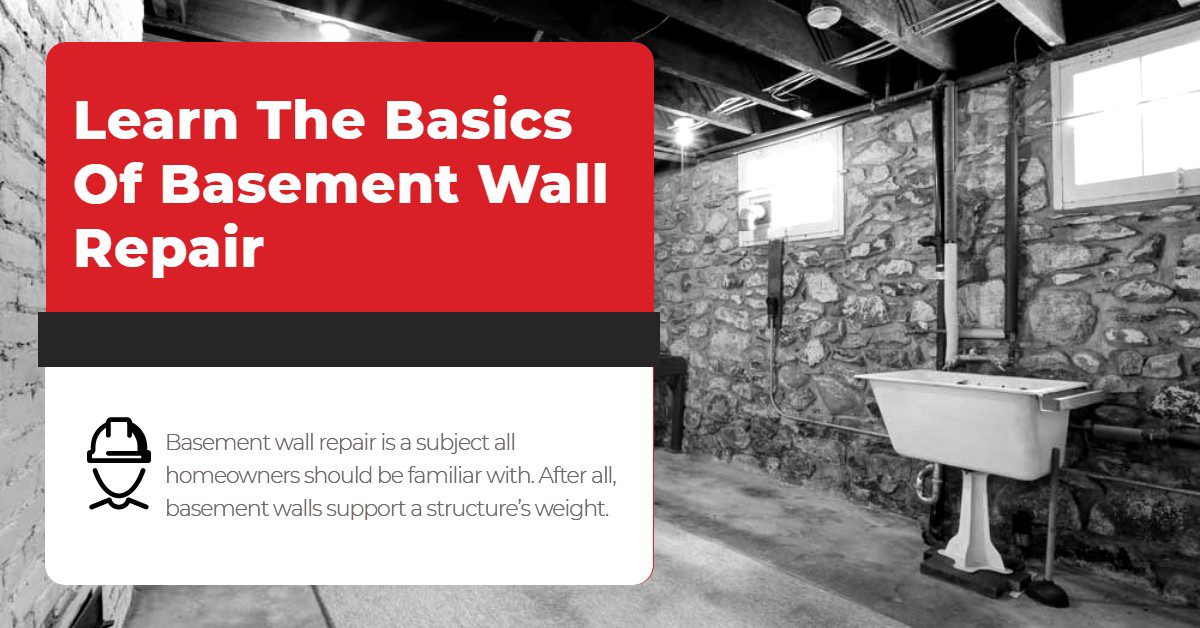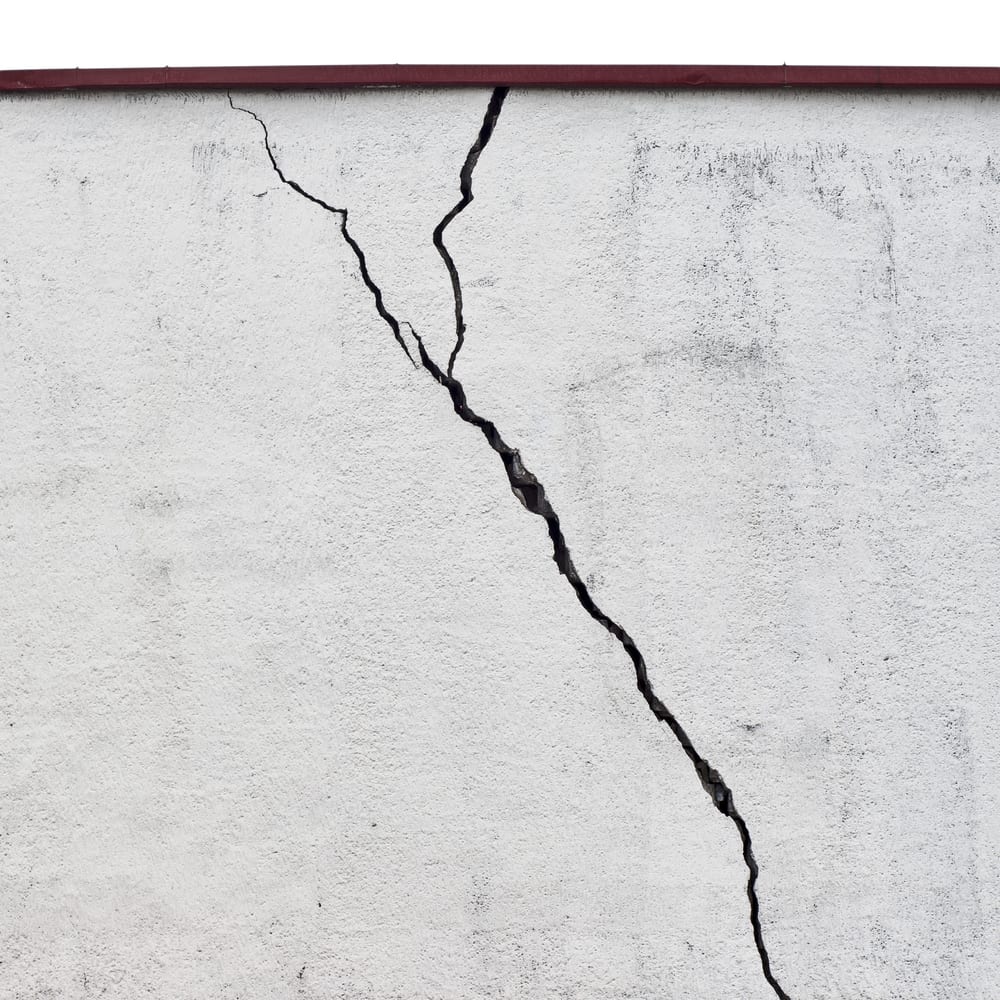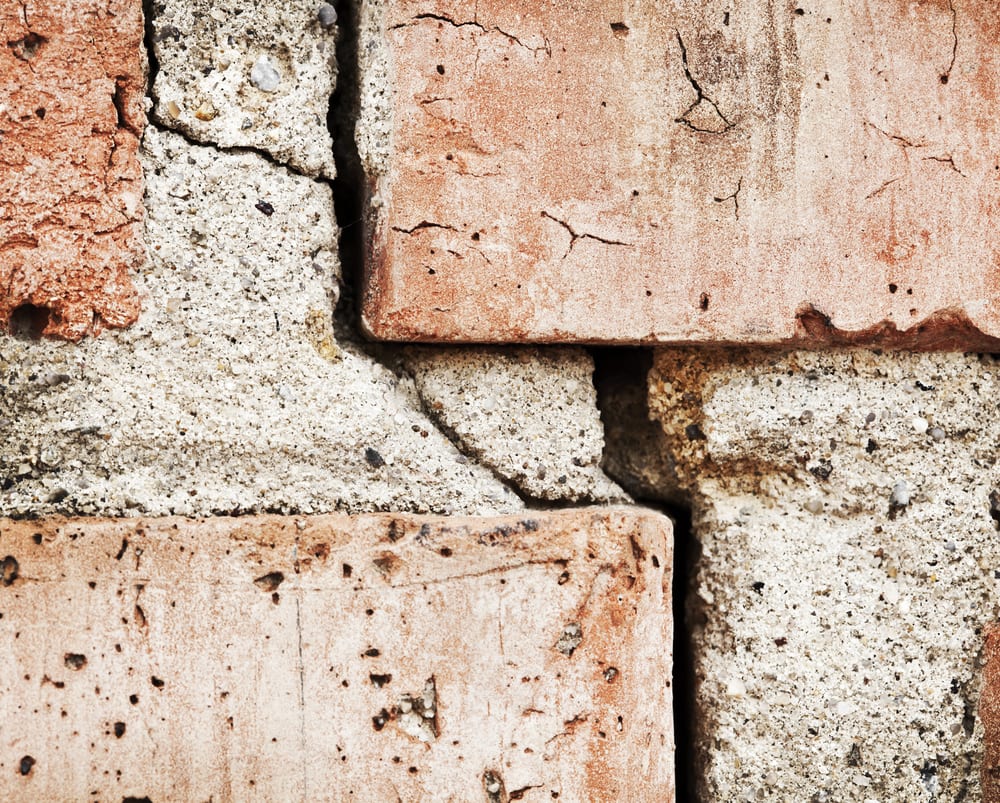Basement wall repair is a subject all homeowners should be familiar with. After all, basement walls support a structure’s weight. They also work to keep moisture out, thus ensuring a dry environment inside the building. However, that doesn’t mean they’re impenetrable…
Concrete is a porous material and will absorb moisture from the environment. If the soil around your foundation is water-saturated, you’re going to have problems because any fluid in a confined space exerts pressure on the wall of the container. This is referred to as hydrostatic pressure, and this pressure will be greatest at the bottom of the container due to gravity and the density (unit weight) of water. Hydrostatic pressure will push moisture into basement walls via cracks and joints, If cracks are present throughout the foundation, you’ll end up with a wet or damp basement.
Moisture in your basement will contribute to mold growth and could, if it gets bad enough, damage both carpets and furniture. You really don’t want moisture in your basement.
Why basement walls crack
Horizontal cracks located in the upper portion of your basement wall
If you see horizontal cracks in the upper area of your basement wall, you might have…
A cold joint. A cold joint happens when a new batch of concrete is poured onto a previous batch of concrete that has already started to set. This delay in pouring the second batch hampers the ability of the two batches of concrete to mix and this forms a weak point known as a ‘’cold joint’’. A cold joint in your basement wall can cause a horizontal crack.
Frost damage. If you live in a cold climate, it’s important to keep water from pooling around your home’s perimeter. When water-saturated soil around the perimeter of your home freezes, it puts additional pressure on your basement walls and could cause them to crack.
Pressure caused by heavy objects. If something heavy – a large truck, for example – parks close to your basement wall, it puts additional pressure on the soil. The soil then puts pressure on your basement wall and this results in cracks or bulging walls.
Impact damage. This is caused by something heavy hitting the side of your home and causing the basement wall to crack and bulge.
Horizontal cracks located in the middle of your basement wall
If you see horizontal cracks located in the middle area of your basement wall, you might have…
Pressure caused by heavy objects. Like horizontal cracks located in the upper area of your basement wall, cracks in the middle of the basement wall can also be related to something heavy near the wall. For example, a large truck or a piece of equipment
Pressure caused by the soil itself. Soil alone can cause damage to a wall if the wall isn’t strong enough to support it. Certain types of soil can weigh up to 135 lbs. per cubic foot and water weighs 62.4 lbs. per cubic foot. Homes built on hillsides in regions with a lot of rain or frost often experience this particular problem.
Horizontal cracks located near the bottom of your basement wall
The pressure soil exerts against a foundation increases as you go down. Therefore, the greatest amount of pressure will be near the bottom of the basement wall. If the soil is saturated with water, that’s even more pressure against the side of the foundation. In fact, there’s a risk that the pressure could eventually push on the foundation so hard that it causes the basement wall to lean or bulge. If you have a leaning or bulging basement wall (or any wall for that matter), contact a foundation repair specialist immediately.
Vertical basement wall cracks
Typically, any vertical cracks (like in the photo above) in a structure indicate differential settlement. Therefore, if it’s more than just a hairline crack, you should get it checked out.
Diagonal basement wall cracks
Diagonal, or stairstep cracks, in bricks or masonry are usually caused by either differential settlement or – if you live in a cold region – something called frost heave. If you notice stairstep or diagonal cracks, contact a foundation repair professional for an inspection.
How do you know if a basement wall crack is serious?
Not all basement wall cracks indicate structural damage. Basement wall cracks not related to structural damage can be easily filled and you can probably do this yourself. However, basement wall cracks caused by movement in your foundation need to be fixed by a foundation repair specialist.
As we mentioned above, all new homes settle to some extent and even this perfectly normal settling can cause small, hairline cracks. Therefore, cracks this size probably aren’t anything to worry about, especially if they don’t get any bigger. However, if you’re not sure, it’s best to contact a foundation repair specialist and ask them to come out and perform an inspection. They’ll be able to tell you if the cracks in your basement wall are a serious threat to your home’s structural integrity. If they are, they’ll be able to offer a repair solution that can structurally repair the wall and stabilize your home.
Repairing a basement wall
When it comes to basement wall repair, there’s no cookie cutter solution. While hairline cracks that aren’t growing in size can probably be fixed by the homeowner, larger cracks, or basement walls that are leaning or bulging, are jobs for an experienced foundation repair specialist.
At Foundation Professionals of Florida we fix basement walls using wall plate anchors, carbon fiber solutions, and curtain grouting, a permanent waterproofing technique.
The good news is that most basement wall cracks aren’t caused by structural damage. However, that doesn’t mean they’re harmless. Basement wall cracks can allow both water and radon gas to enter your home. So, they should be filled. You can probably do this yourself if you’re absolutely sure the cracks weren’t caused by structural damage.
What causes foundation problems?
Most foundation problems are caused by too much moisture under the foundation which leads to movement under the foundation causing differential settlement.
Common causes of foundation problems include…
- Expansive soil. Expansive soils are those that easily absorb and release water. As they absorb water they expand, and as they release water they shrink, often a considerable amount. This cycle of soil movement – which is often seasonal – puts a lot of stress on a foundation.
- Improperly compacted soil. Soil that wasn’t properly compacted prior to construction can cause movement (post construction soil consolidation) under the foundation and lead to major structural issues.
- Drainage problems. Water that isn’t properly channeled away from a foundation will eventually saturate and destabilize the soil. A sewer pipe leak can do the same thing if it isn’t repaired in a timely manner.
- Invasive tree roots. Tree roots are always seeking out sources of water. If it’s under your foundation, they’ll go there in order to get it.
- Earthquakes and floods. We probably don’t need to explain how earthquakes and floods can damage foundations.
- Droughts. Droughts – especially in regions with expansive clay soil – can damage foundations due to soil shrinkage.
- Sinkholes. This is a big problem in central and northern Florida.
Signs of foundation problems
Differential settlement can lead to structural damage and make your home unsafe. It can also lower its value. If you see any of the following – or anything else you think is suspicious – contact a foundation repair specialist immediately and ask them to come out for an inspection:
Interior signs of foundation problems
- Doors and windows that don’t open as easily as they once did.
- Doors and windows that don’t properly close. For example, maybe there are gaps.
- Cracks in walls, floors, and ceilings.
- Cracks in drywall.
- Floors that are no longer level.
- An egg that wont stay put when you lay it on the counter top
Exterior signs of foundation problems
- A cracked or broken foundation.
- Wall rotation or tilt. This can happen when the soil around your foundation gets saturated with water. The outside edge of the foundation sinks deeper into the soil while the inside edge pulls up. The wall then rotates or tilts as a result.
- Windows or doors that are separating from the walls.
- Stairstep cracks in bricks and masonry.
- Moldings that have been displaced.
- A leaning chimney or porch.
Basement walls support the weight of a building and help keep moisture out. However, since concrete is porous and behaves something like a sponge, it can be penetrated by moisture. When this happens, you’ll end up with a damp basement and – if the problem isn’t repaired right away – wall damage.
Read more about – Are you making these foundation drainage mistakes?
While it’s certainly possible to repair small basement wall cracks – the kind that have been caused by normal settling – larger cracks definitely need to be inspected by a professional to make sure they haven’t been caused by structural damage.




